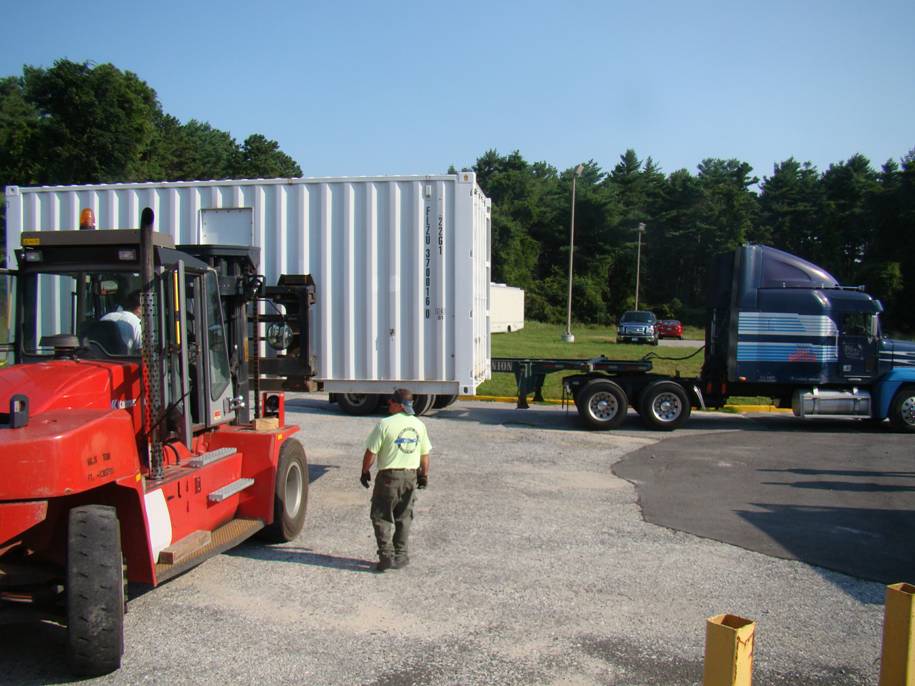Aerosol Observing System Gussied Up to Go Out
Published: 27 September 2013
Editor’s note: Stephen Springston, a scientist from Brookhaven National Laboratory, shared this update in August 2013 about a new Aerosol Observing System (AOS).
Originally deployed in Australia, the next-generation aerosol observing system (AOS) system returned to Brookhaven National Laboratory this summer for an invigorating makeover. With instrument, computer, and infrastructure systems rearranged and updated, and a fresh coat of paint, she is ready to go back out into the field as part of ARM’s new Eastern North Atlantic (ENA) site!

Key features of this new, next-generation AOS system include:
- Self-containment for shipping and deployment. All instruments are installed in shock-mounted racks, plumbed, wired, with railings and a 10-m above-ground level sampling inlet. All that is required on-site is power and internet connectivity.
- Robust construction of the aerosol inlet. Shielded pump enclosures and the ability to go into “turtle mode” give ample protection against outside elements. They have proven their mettle in hurricanes—winds above 70 mph—and temperatures from -15°–40°C. Not to mention, there was a minor earthquake here at BNL during the Aerosol Life Cycle IOP, and everything survived!
- Standardized computer acquisition provided for multiple instrument systems. BNL has written “wrappers” in National Instrument’s LabView language for acquiring data, and in most cases controlling the instruments with a uniform graphical user interface for the operator. The internal computer systems are based on multiple copies of a fanless computer all backed up for disaster recovery. In addition to the site collector computer that transmits hourly data files to the ARM Data Management Facility, BNL records the primary data on at least two internal computers for redundant storage of the measurement data.
- An infrastructure computer with manuals. Equipped with manufacturer instrument manuals, material safety data sheet (MSDS) documentation, and the dynamic standard operating procedures manual, on-site operators have all necessary documentation. In addition, mentors can work directly with operators using Skype and video conferencing.
- Remote control of instruments, infrastructure, and data systems. Three different local area networks (LANs) are inside the AOS systems: an instrument network, a public network, and a guest instrument network. For the first time, BNL has implemented a remote infrastructure monitoring of systems, such as pump temperature/pressures, cabin temperature/relative humidity, and line voltage with a 16-channel health monitor in the ENA AOS. In the case of power failures, the central computer restarts instrument systems in a gradual, ordered fashion using programmable power distribution units. Mentors do not have to be on-site even for sophisticated instruments.
Based on new opportunities and availability of new instrumentation, the AOS is planned to have enhanced capabilities (which eventually will be shared by AMF2 and AMF3 systems).
The new capabilities, scheduled for on-site integration in FY2014, include:
- CAPS (cavity attenuated phase shift) particle extinction monitor to provide a direct measurement of particle optical extinction
- CO/N2O/H2O gas-phase monitor
- CO2/CH4/H2O gas phase monitor, and
- UHSAS (ultra-high sensitivity aerosol spectrometer) to provide size distribution information.
A special thanks to BNL’s Gunnar Senum, Chongai Kuang, Tom Watson, and Cindy Salwen for the extra effort preparing the ENA AOS for its departure to a new home.
Stay tuned for an exciting new datastream!
The ARM Climate Research Facility is a DOE Office of Science user facility. The ARM Facility is operated by nine DOE national laboratories, including .
Keep up with the Atmospheric Observer
Updates on ARM news, events, and opportunities delivered to your inbox
ARM User Profile
ARM welcomes users from all institutions and nations. A free ARM user account is needed to access ARM data.


















